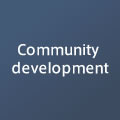Daiwa House Group’s Developing new communities
The first net zero energy town in the Hokuriku Region, featuring full countermeasures against possible natural disasters
SECUREA Toyota Honmachi (under development)
SECUREA Toyota Honmachi is a multi-use development being undertaken on the site of a former elementary school in the city of Toyama. The project goes under the name of a safe & Eco-smart Model City Block Development Project in Toyama City, and when completed will consist of housing plus a multipurpose public facility including a community center, city government sub-office, and library. The housing development will be the first net zero energy community* in any of the three prefectures (Toyama, Ishikawa, and Fukui) of the Hokuriku Region. The public facilities project, which has already been completed, is the first construction in the D's SMART OFFICE brand constructed by the Group as a public-private partnership (PPP).
- *1 According to Daiwa House Industry
- * A town where the annual net primary energy consumption is zero or almost zero as a result of the improvement of the energy saving performance of the skeletal structures and facilities of houses and the effective use of renewable energies. This calculation does not include the regional center .
- Development area: 8,381.26m2
- Total units: 21 single-family houses, 1 meeting hall
![]()
Under the "Future City" concept being promoted by the Japanese government, the "Toyama Eco-Friendly Future City Plan" proposed by the Toyama municipal government has been selected as one of these "future cities." The core policy under this plan is to link the Toyama city center area with other regional business/shopping hubs via public transportation, to create a compact, convenient network in which all the necessary urban daily-life features are available within walking distance of everyone's home. The provision of " a safe & Eco-smart Model City Block Development Project" forms one element in realizing this concept. To facilitate the construction of high-quality housing that offers residents the convenience of living close to public transportation (railway or subway) lines and that is also designed to be eco-friendly, the plan seeks to develop residential communities in underutilized areas served by public transportation arteries. These housing developments will be safe and pleasant places to live that are also environmentally sound.
The Daiwa House Group was selected by an open-bidding process to undertake the first safe & Eco-smart Model City Block Development Project.
The housing area equipped three batteries and the development as a whole constitutes a net zero energy community. The park located in the center of the community includes a number of disaster-countermeasure features.
The multipurpose public facility (community center, regional center, and branch library) will be constructed under the build-transfer method as a public-private partnership (PPP), in which Daiwa House is responsible for planning, design, construction, and project management, and sells the completed project to Toyama City. The city has approved the use of our "D's SMART OFFICE" brand model, incorporating the use of high-performance insulation and renewable energy sources, as well as equipment enabling the full range of energy generation, conservation, and storage.
The Daiwa House Group promotes its D's SMART Series as a construction business and its SMA×ECO PROJECT (which allows us to make proposals for low environmental impact sustainable residences and lifestyles) as a housing business. In this project, we leverage the technologies we have created and the know-how we have accumulated in the fields of construction and urban development, and we believe that it is an ideal opportunity to demonstrate the advantages of the public-private partnership method in the field of community development.

Residents' park and public facility offer disaster-mitigation features
The park includes pergolas that can be converted into first-aid stations, and benches that also function as toilets for use in emergencies. There is also a storeroom that houses equipment for use by the residents in the event of a natural disaster, and photovoltaic power generation equipment and lithium-ion batteries. The park can serve as a refuge and rallying-point for the residents in the event of a major disaster.
All electrical cables are laid underground, so the streets are free of utility poles, which may be toppled by a strong earthquake and thus obstruct traffic, including fire engines. This reduces the likelihood of secondary damage from fires.
Daiwa House has signed an agreement on disaster prevention with Toyama City, as part of which the facilities within the park will be used in the event of a disaster, as well as the equipment kept in the storeroom.
As the public facility buildings will be used as a local administrative center in the event of a major disaster, they are fitted not only with photovoltaic power generation systems (including lithium ion batteries) but also with a micro-cogeneration system*, thereby diversifying the district's energy supply and ensuring maintenance of power. Micro-cogeneration systems have the advantage of enabling faster-than-normal post-disaster recovery of gas supply because gas pressure governors are installed in the development site.
* The cogeneration system uses clean natural gas to drive an electric power generator. Heat produced during power generation is employed in heating water and powering room-heating/cooling equipment, thereby minimizing energy loss.
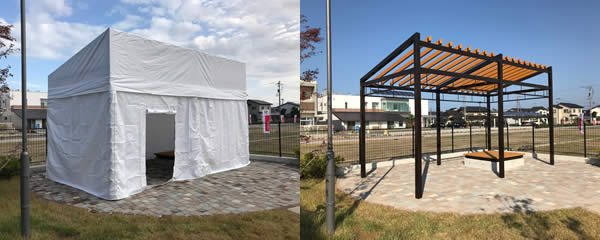 The pergolas can be fitted with covers as shown in the photograph at left, enabling their use as first-aid stations or sorting areas for relief supplies following a natural disaster.
The pergolas can be fitted with covers as shown in the photograph at left, enabling their use as first-aid stations or sorting areas for relief supplies following a natural disaster.
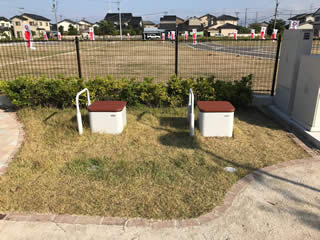 These benches—which are directly connected to the sewer system—also function as emergency toilets for use after a disaster.
These benches—which are directly connected to the sewer system—also function as emergency toilets for use after a disaster.
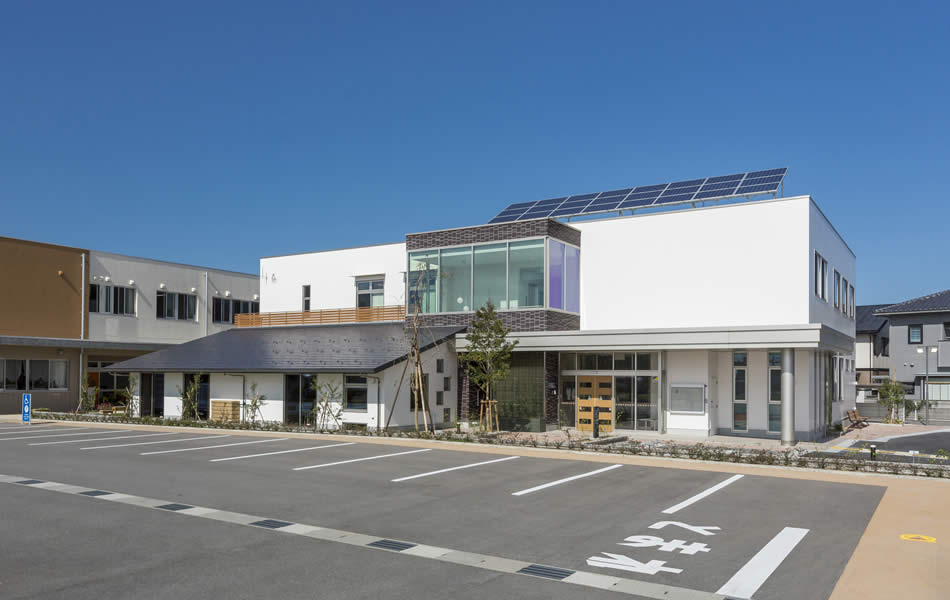 The public facility within the development area (community center, regional center, and branch library)
The public facility within the development area (community center, regional center, and branch library)

Creating an open, expansive residential area by the use of underground distribution lines
In order to create an attractive landscape that harmonizes well with the interior design of the homes, and pass it on to succeeding generations, while protecting the real estate value of this development, the Group has reached an agreement with the residents and laid down a set of guidelines.
By laying electric power distribution lines and telephone lines, etc. underground, we have avoided the usual ugly clutter seen in Japan's residential areas, caused by utility poles and the lines strung between them. This gives the residents a clear and attractive view in all directions.

Association formed to oversee maintenance of anti-disaster facilities and equipment, and maintain the external appearance of homes
The anti-disaster storeroom, photovoltaic power generation equipment, and lithium-ion batteries are owned and managed by the residents. To facilitate effective management, a community’s management association has been formed.
To ensure the maintenance of the external appearance of each house and other buildings as well as the upkeep of each home's garden and other surrounding greenery, we have reached an agreement with the residents, and this agreement has received the approval of the Toyama municipal government. In parallel with this, we have set up a Home Owners Committee to serve as the organizing body whereby residents can continuously maintain the terms of the agreement.

Support for autonomous activities by the community’s management association
To foster a local community spirit, we have designated the details of the services entrusted to the management company, as well as the contractual term of service. This is to enable the community’s management association to engage in the necessary autonomous activities (holding general meetings and governing board meetings) as well as various events such as replanting by the residents themselves in the common-use greenery areas.
 Replanting by residents in the common-use greenery areas
Replanting by residents in the common-use greenery areas

All homes fitted with three batteries, and all residents can make use of the equipment in the public facility
Each home is fitted with three batteries (a photovoltaic power generation system, a lithium-ion storage battery, and a fuel-cell battery) and its specifications conform to those of a net zero energy house (ZEH*).
In addition, a commonly-owned photovoltaic power generation system and lithium-ion batteries are also installed to supply power to the common-use spaces in the housing development. By these means, the development as a whole (the residential portion only) is realized as a "net zero-energy community."
The public facility is fitted with a photovoltaic power generation system, lithium-ion batteries, and a gas cogeneration system. The gas cogeneration system will operate during the cold months (November-April), with the waste heat from the system being used to warm the facility's main hall and corridors. Taking into account the probable usage pattern and usage frequency for the individual rooms, a combination of heat-pump air-conditioning units employing electric motor heat pumps and units employing gas heat pumps has been selected.
The SMA×ECO Cloud system is used to facilitate easy visualization of energy usage at the whole-community level.
* ZEH = A house whose net annual consumption of primary energy is approximately zero
Administrator’s voice
Mitsuharu Tofuku
Deputy Manager, Environmental Policy Department Environmental Division Toyama City
Regional cities in Japan are currently seeking a variety of collaborative relationships to help solve problems such as population aging—which has reached unprecedented levels—as well as labor shortages and a lack of technological skills. From here onward, I believe it will be important for us to form cooperative ventures with private corporations to simultaneously meet the needs of government and the private sector.
In addition, both private businesses and government offices must stop thinking that social issues are somebody else's problem. I hope that by linking arms to realize sustainable development goals (SDGs), the government and the private sector will be able to generate new added value for everyone.
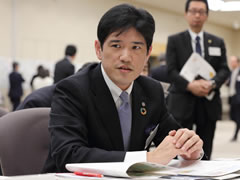
Daiwa House’s voice
The project we have discussed here is a model of how we can leverage the strengths of Daiwa House Industry in the fields of new community development and multipurpose development through collaboration among many different divisions of the Company as well as with a local government authority. Going forward, I hope that we will be able to work with the residents as well as the staff of Toyama City Office to make this new community even better, and that we will apply the know-how gained in the process to further projects in the future.
 Tomonori Inoue
Tomonori Inoue
Design Group Development Department Osaka Urban Development Division
-
 Japan's first, next-generation Net-Zero Energy community
Japan's first, next-generation Net-Zero Energy community
"SMA x ECO TOWN Harumidai" -
 New smart town where sales revenue from the town is returned as living support service
New smart town where sales revenue from the town is returned as living support service
"SMA x ECO TOWN Hidamari-no Oka" -
 Multigenerational community development to revitalize a new town
Multigenerational community development to revitalize a new town
"Midorigaoka and Miki Aoyama Housing Complex Revitalization Project" -
 A water town that utilizes the power of wind, sun, greenery and nature
A water town that utilizes the power of wind, sun, greenery and nature
"Lake Town Miwa-no Mori" -
 First community in Japan to take advantage of power interchange system among multiple single-family houses
First community in Japan to take advantage of power interchange system among multiple single-family houses
"SECUREA Toyota Kakimoto" -
 Community development that integrates residences with shops, including a large-scale commercial facility
Community development that integrates residences with shops, including a large-scale commercial facility
"Takao Sakura City" -
 The first net zero energy town in the Hokuriku Region, featuring full countermeasures against possible natural disasters
The first net zero energy town in the Hokuriku Region, featuring full countermeasures against possible natural disasters
"SECUREA Toyota Honmachi" -
 Each house is fitted with three batteries, and a home energy management system (HEMS) that enables easy tracking of energy usage
Each house is fitted with three batteries, and a home energy management system (HEMS) that enables easy tracking of energy usage
"SMA×ECO CITY Tsukuba Science City" -
 Achieving reconstruction through area management in cooperation with the people
Achieving reconstruction through area management in cooperation with the people
"Kyassen Ofunato" -
 Japan’s cutting-edge biomedical town
Japan’s cutting-edge biomedical town
"King Skyfront District A (under development)"



